
VIRGINIA JOURNAL of
EDUCATI N December 2022
We have a teacher shortage. We also know how to fix it.
The magazine of the Virginia Education Association
Editorial Assistant/Advertising Representative


Kate O’Grady
Contributors
Alyce Pope Bill Pike
Monte F. Bourjaily Bruce Ingram
Sarah Flippen
Rachael Rudis
Vol. 116, No.3
Copyright © 2022 by the Virginia Education Association
The Virginia Journal of Education (ISSN 0270-837X) is published six times a year (October, November, December, February, April and June) by the Virginia Education Association, 116 South Third Street, Richmond, VA 23219.
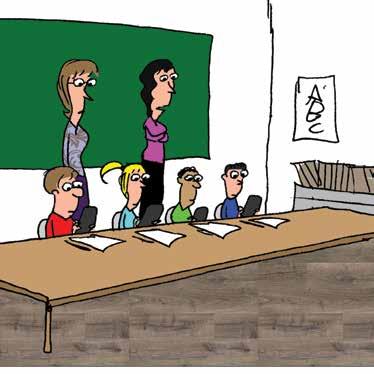
Non-member annual subscription rate: $10 ($15 outside the U.S. and Canada). Rights to reproduce any article or portion thereof may be granted upon request to the editor. Periodicals postage paid in Richmond, VA.
Postmaster: Send address changes to Virginia Journal of Education, 116 South Third Street, Richmond, VA 23219.

Article proposals, comments or questions may be sent to the editor at tallen@veanea.org or Tom Allen,116 South Third Street, Richmond, VA 23219, 800-552-9554.
Member: State Education Association Communicators


VEA Vision:
VEA
Scott
Editor
Tom Allen
VEA President Dr. James J. Fedderman
VEA Executive Director Dr. Brenda Pike
Communications Director Kevin J. Rogers
Graphic Designer Lisa Sale
CONTENTS COVER STORY We have a teacher shortage. We also know how to fix it. 8 FEATURES 14 The Next Step Professional growth opportunities for education support professionals. 15 Identity, Manipulatives, and Mistakes A better way to teach math. 18 We Need a Deeper Dive Test scores alone don’t tell us what we really need to know.
20 Membership Matters Big plans for Lobby Day; VEA’s 2023 Legislative Agenda. 25 Insight on Instruction Those ‘closest to the pain’ should be ‘closest to the power.’ 30 First Person Amazing, creative lessons happen every day.
4-7 This month: A clearer picture, electric school buses, and Touching Base With Alyce Pope of Fairfax County. Cover design by Lisa Sale; images by iStock. “Well, at least I don’t have to tell them to stop talking now.”
DEPARTMENTS
UPFRONT
A great public school for every child in the
of Virginia.
Commonwealth
is to unite our
and local communities
Mission: The mission of the Virginia Education Association
members
across the Commonwealth in fulfilling the promise of a high quality public education that successfully prepares every single student to realize his or her full potential. We believe this can be accomplished by advocating for students, education professionals, and support professionals.
“I’m going to need better arguments from you than ‘Am too!’ and ‘Am not!’”

Getting a Clearer Picture of Success

It is unfortunate and unfair that public K-12 schools in Virginia and other states are judged solely on standardized test scores and do not recognize the tremendous effort and success that comes from classroom teachers and their colleagues working together to maximize student achievement.
The true measure of a school’s success is its ability to determine where the student is upon arrival, where that student is capable of going, and creating academic, emotional, and social successes for that student.l
— Robert Holt, a former member of the Franklin City School Board chosen as a 2021 School Board Member of the Year by the Virginia School Boards Association.

Our Five Best Weapons Against Burnout?
It’s no secret that burnout was an issue for teachers before COVID, which only served to exacerbate the problem. Here are the top five things that would most effectively alleviate the problem, drawn from a survey NEA took earlier this year:
1. Raise salaries.
2. Hire more teachers.
3. Provide more mental health and behavioral support for students.

4. Hire more support staff.
5. Reduce the amount of paperwork required.l

There’s No Trophy for this One
81.8
Percent of LGBTQ+ students who report feeling unsafe in school because of at least one of their actual or perceived personal characteristics.
Source: GLSEN National School Climate Survey
“Want
We’re on pace to break an impressive record in 2022— but it’s nothing to jump up and down about. In the current political climate, the American Library Association reports that by September of this year, we were on track to break 2021’s record-setting number of attempts to ban or restrict library materials in schools, universities, and public libraries.
In the first eight months of 2022, ALA documented 681 attempts to do so, with 1,651 titles targeted. In all of 2021, ALA says there were 729 attempts to ban or restrict library resources, the largest amount in the more than 20 years ALA has been keeping track.l
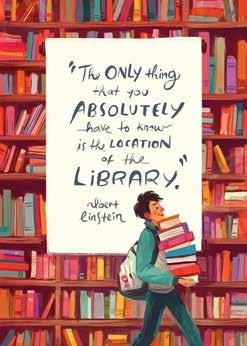
TOUCHING BASE WITH…
ALYCE
POPE
FAIRFAX
EDUCATION ASSOCIATION Family Services Specialist, Pre-K and Early Head Start
What do you like about your job?
I get to have an early impact in children’s lives by identifying needs, strengths and resources in the community. Fairfax is a very diverse community, with ever-shifting demographics that can look different in various areas of the county. I meet oneon-one with over 100 families as they enroll their child in our program, hear their stories, and help develop a Family Action Plan/Partnership agreement that focuses on short- and long-term goals for the wellbeing of the child and the family.
How has being in the Union helped you?
I attended FCPS Public Schools, as did my children and now my grandchildren, and I was very aware of some of the challenges people of color and differing abilities faced as students and staff. When I became a FCPS employee, saw and experienced these challenges from an insider perspective. My union allows me to speak truth to power in an educated and supportive way. It also give me lots of training and a chance to dialogue and develop possible solutions with others vested in the success of our public schools. Strong public schools are a necessity to maintaining a strong democracy. l
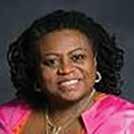
4 VIRGINIA JOURNAL OF EDUCATION | DECEMBER 2022 VIRGINIA JOURNAL OF EDUCATION DECEMBER 2022 5 UP FRONT
Photo
and illustrations by iStock
to hear about my day now, or just wait until the principal calls?”
Too Much Smoke
Despite the best efforts of many educators, a federal government study released in November shows that just over 11 percent of all students in middle and high school vaped or used cigars, cigarettes, or some other tobacco product in the previous 30 days in 2022.l

‘Back to School Night’ for Legislators?
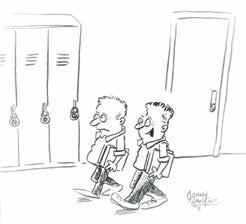
How many teachers are disheartened and even scared by the restrictive legislation involving school curriculum and materials like books in states across the country?
While those most affected are those teaching social studies, literature, and the social sciences, a policy stance that imposes bans is a threat to us all. The clear message that politicians are sending (including in Virginia) for teachers with these laws is “we don’t trust you.”
Do legislators know how hard educators work to master the content, understand the curriculum, plan lessons, and cultivate within students the intellectual independence necessary to participate in our self-governing society?

I want to make a practical appeal to my fellow teachers: Could you take an hour to write as few as 250 words to your state legislators (find them at whosmy.virginiageneralassembly.gov) that open the door to your classroom, to share the important work you do, why you do it, and what concerns you as a constituent? Think of it as Back to School Night for legislators.
Fairfax Education Association member Monte F. Bourjaily (Excerpts from his article, “Some Politicians Count on Teachers Staying Silent. We Can’t Afford To,” which first appeared in Education Week on October 03, 2022. Reprinted with permission from the author.)l
Why, Indeed?
The defined benefit plan that I retired under is no longer available for our current new hires. Why? The Virginia Retirement System is doing well. Why change something that is a great benefit and a wonderful tool to use to encourage young people to go into the profession?l

homework
We’ve Always Known that Things on School Buses can get Electric…

Because the number of school districts that would like their school buses to run on electric power has jumped so dramatically, the Environmental Protection Agency has decided to almost double its available funding to states to help make such buses more common.
EPA offered some $500 million earlier in 2022 and then boosted it to $965 million later in the year. There’s expected to be an additional $1 billion in the new budget year, all in response to what the agency calls “overwhelming demand.”l
You May Qualify for Disability Retirement
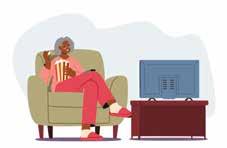
If, during your teaching career, you’ve heard any of the following questions or excuses more than 7,500 times, you may qualify for disability retirement immediately:

• “Does spelling count?”
• “Will this be on the test?”

• “Do we have to take notes?”
• “Can we see a movie today?”
• “Are we doing anything today?”
• “Why do we have to do this?”
• “Can I do extra credit?”
• “Ms. Jackson used to let us.”
• “You’re the only teacher who makes us…”
• “You didn’t say we had to bring…”
• “I didn’t do anything.”l
Source: Teachers by Art Peterson
“You got an email from school about me? Well, like you always say, ‘You can’t trust anything on the internet.’”
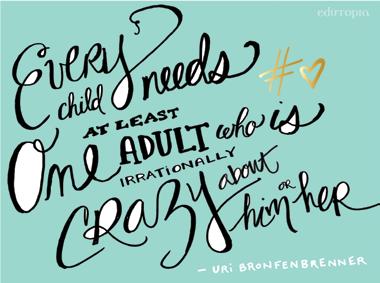
6 VIRGINIA JOURNAL OF EDUCATION | DECEMBER 2022 VIRGINIA JOURNAL OF EDUCATION | DECEMBER 2022 7 UP FRONT
by iStock
Photo illustrations
— Former Chesapeake superintendent Dr. James T. Roberts
“My excuse for late
is so good I have a patent pending on it.”
THE SHORTAGE
OUR KIDS NEED TEACHERS. HERE’S HOW TO FIND THEM.
 By Tom Allen
By Tom Allen
VEA President Dr. James J. Fedderman would like you to know that, at its core, this ain’t rocket science. “We all know we have a teacher shortage in Virginia and the reasons for it aren’t a mystery to anyone who’s been paying attention,” he recently told state media outlets. “Our teachers are not only underpaid, but do their jobs under almost unbearably difficult working conditions. They
don’t get the respect they deserve, and they aren’t given the resources they need to most effectively serve our students.”
The problem is clear-cut, and the stakes are incredibly high. Fortunately, the factors in a multi-prong approach to solving this problem are equally obvious. What remains is bringing our actions and political will in line with what we claim to value.
A Place at the Table
A great place to start is at the negotiating table. One of the most direct and effective ways to put a meaningful dent in our shortage, Fedderman says, is giving teachers a role in contract negotiations. “If the new collective bargaining law for school employees that we helped get passed was in place widely around our state,” he notes, “educators and local school leaders would be negotiating effective ways to fix teacher shortages in their communities.”
A recent study backs VEA’s position that this would be a good move for everyone. The Commonwealth Institute, a Richmond-based think tank that advocates for racial and economic justice in public policy, issued “Collective Bargaining: A Critical Tool to Improve School Staffing, Pay and Morale,” in October. After presenting evidence that contract negotiations boost teacher and staff pay, improve working conditions and morale, help build retention and, on top of that, are good for student achievement, the report concludes, in part: “Our public education system’s most valuable resource – its people – has long been forced to do increasingly more with increasingly less. And the COVID-19 pandemic has deepened the strain on teachers and school staff. Collective bargaining is a critical aspect of how to correct this dynamic…It is time for all local school boards to support teachers and school staff by permitting them to collectively bargain.”
Virginia’s collective bargaining law for public employees requires local unions and school boards to jump through a number of challenging hoops, however, so the process for having negotiations in
place around the state is an ongoing and lengthy one.
Cha-Ching, or Lack Thereof…
What’s also been a far-too-lengthy process is making payday a better and more deservedly-happy day for our commonwealth’s teachers. Here are a couple numbers that are surely a major factor in our current shortage: Virginia’s teachers are currently paid an average salary of $58,506, which translates to $6,787 less than the national average salary for teachers. That’s over 10 percent less than the national average, in a state that has consistently offered one of the country’s best systems of public schools—and a state with the financial ability to do far better.
and energy at additional jobs, students are shortchanged.”
Research shows (though common sense seems sufficient) that better pay and benefits go a long way in helping attract the best and the brightest. And don’t we want the highest-quality individuals we can find at the front of our classrooms?
Seeing one’s vocation as a calling, as many teachers do, is a wonderful and fulfilling thing. Why do we expect people who follow their calling, or choose their career because it’s something they love, to do so at such financial sacrifice?
Incidentally, research also shows that effective teachers are the single most important factor in students’ academic success. Doesn’t it make sense to invest in them?
Under These Conditions…
“We’ve always said that teacher work conditions are student learning conditions,” says Fedderman. “When you improve one, you automatically improve the other.”
That’s inexcusable.
“Far too many of our educators, both teachers and support professionals, must work second and third jobs to pay their bills,” says Fedderman. “We say that education is an extremely important profession, the one that makes all others possible—but what other profession has to do that? When’s the last time you saw a lawyer waiting tables part-time? When educators spend time
And there is lots and lots of room for improvement in the working environment for teachers. Some of the primary factors in a teacher’s work world are teacher and schoolleadership, educator voice, community support and parent engagement, time for teaching, class size and caseload, student conduct, physical and cultural environment, professional learning and collaboration, and assessment cultures, according to the National Education Association. Here are some much-needed steps to create an atmosphere that will pay off for both students
COVER STORY
Photo by iStock
VIRGINIA JOURNAL OF EDUCATION | DECEMBER 2022 9
8 VIRGINIA JOURNAL OF EDUCATION | DECEMBER 2022
“Far too many of our educators, both teachers and support professionals, must work second and third jobs to pay their bills.”
and educators:
• Increase staffing, which will bring down class sizes. Fewer students means more one-onone attention for students. More paraeducators means that students with special needs will get more of the services they need.
• Improve mental health services. A teacher on the road to burning out is likely to leave the profession, and not as likely to create a classroom environment that fosters learning as well as it could.
• Restructure teacher workdays. American teachers spend more time in the classroom than teachers in nearly every other
industrialized country, according to OECD. They need time to collaborate and plan.
• Ensure the safety of educators in our school buildings. Too many of those buildings face problems with mold, lead, violence, exposure to chemicals, and poor indoor air quality, among other issues. No one should have to work or learn in conditions that endanger their health.
• Ensure supportive environments for new teachers, teachers of color, and LGBTQ teachers. Just as we welcome a wide variety of young people into our classrooms, we must also welcome diverse educators to our staffs.
Virginia’s ‘Support Cap’ Must Go
When the Great Recession hit in 2009, one of the steps legislators took to save money was the “support cap,” a change to our school funding formula that significantly limited the number of support professionals school systems could hire. While this strategy may have been helpful during that emergency, a decade later it’s contributing to our teacher shortage.
“Since the massive cuts to support staff positions, teachers have had to wear more hats than ever,” says Chad Steward, a VEA policy analyst. “They’re counselors, nurses, librarians, custodians, you name it. Those kind of support positions are mission-critical to schools. No wonder teachers are burning out faster than ever.”
How NOT to Solve the Teacher Shortage
Some approaches that won’t help, but are still very much in vogue in some places:
Make it easier for the under-qualified to get into teaching.
• Florida has created what it calls the Military Veterans Certification Pathway, which allows veterans to get a temporary (5-year) teaching certificate and work as full-time or substitute teachers. They are supposed to be mentored by an experienced teacher. Non-military people with a college degree may also teach full-time with a 3-year temporary certificate before being before they are required to hold a regular certificate.
• Arizona has passed a law that allows undergraduate college students, not even necessarily education majors, to get “on-the-job” training as a teacher in public school classrooms. The state also has a law permitting someone with a high school diploma to get an emergency teaching certificate.
• Here in Virginia, Governor Glenn Youngkin issued a directive that the state “reduce red tape” involved in getting a teaching license “in order to recruit more out of state teachers, retired teachers, career switchers, military veterans and other professionals.” Editorial writers at the (Fredericksburg) Free Lance-Star responded by pointing out that programs like this are “hardly new…and have done little to stem the chronic shortages states face hiring special education, STEM, and foreign language teachers,” adding that these efforts “will not alleviate” Virginia’s teacher shortage crisis.
Undermine public trust in and respect for teachers.
• Teachers in Virginia are now increasingly uneasy about doing their jobs as politics and politicians insert themselves into the classroom. A record number of book-banning efforts (see page 5), growing controversy about even discussing controversial issues in school, and Governor Youngkin’s “tip line” are among factors giving current and future public school teachers second thoughts about their career choices. Add to those developments the scapegoating of teachers for a variety of society’s ills and you’ve got a recipe for teacher departures.
Act like it’s not a real problem.
• Some are downplaying the issue of a teacher shortage. While some areas (typically wealthier ones) aren’t struggling as much as others to fill teaching positions, the Virginia Board of Education, in its most recent edition of the Annual Report on the Condition and Needs of Public Schools in Virginia, noted, “Virginia’s teacher shortage predated the pandemic but is likely to be severely exacerbated by it for years to come.”
• Research done by VEA during the two-day period of August 10-11, 2022, found that across the state, school divisions had 10,499 open positions listed. Not all were for teaching positions (Virginia Department of Education estimate of teacher vacancies, also in August: 3,307), as many divisions were (and remain) scrambling to fill bus driver and other slots, too. But many schools began the year with classrooms led by long-term substitutes and others because they were unable to fill teaching vacancies.l
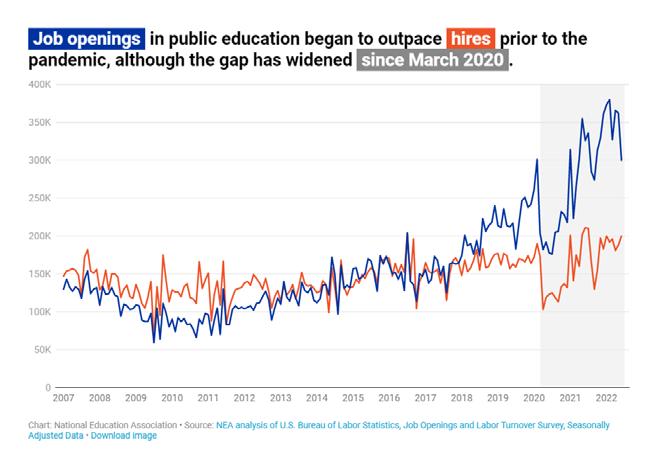
10 VIRGINIA JOURNAL OF EDUCATION | DECEMBER 2022 VIRGINIA JOURNAL OF EDUCATION | DECEMBER 2022 11
COVER STORY
Doing away with the support cap would do two very important things: Bringing in more support professionals would allow teachers to focus on what they do best—teaching, thereby reducing the pressure we’ve put on them, and the increase in state funding would free up local dollars, allowing them to help pay teachers what it takes to attract and retain them.
A Very Important Addition
Our teacher shortage, sadly, is often felt most in the areas where we most need excellent teachers. “Teacher vacancy rates are twice as high in our highest poverty school divisions compared to our lowest poverty divisions,” says Stewart.

Again, it’s not rocket science: Virginia doesn’t come close to providing our highest-need schools with the resources to serve all students,” says Stewart, leaving teachers in those schools with nearly insurmountable
challenges. “Our school funding formula leads to many high-poverty school divisions having among the lowest per student funding levels. This is upside down from what education experts say is needed.”
The best option in our state budget to correct this is the At-Risk Add-On, which ties state support to schools based on the share of low-income students. Without a major funding boost to this mechanism, which would allow high-poverty schools to better hire high-quality teachers, inequities will only grow—and so will teacher shortages.
Barrier-Busting
We know that many of our students face significant barriers to academic success because their basic needs aren’t being met. We also know that community school models are effective in breaking
those barriers down. A community school is set up to offer wraparound health services, before and after school learning opportunities, coordinated family and community engagement, and can also use existing local, state, and federal resources to create even more services based at the school.
“Across the nation, community schools are being looked at to bridge the gap between what students are getting and what they need,” says Dr. Amber Brown, VEA’s Teaching and Learning Specialist. “This benefits everyone—students, families, educators, and community stakeholders. The NEA has been a strong advocate for this work and provides support and assistance for states that are having these conversations.”
Community schools, in addition to going a long way in helping more at-risk students succeed, would also be effective shortage-fighters:
When students are free to learn, teachers are free to teach, leading to better outcomes for everyone. Community schools are a savvy investment for our legislators to consider.
Can We Please Meet Our Own Standards?
Every two years, the Virginia Board of Education revises the state’s Standards of Quality, which are essentially the minimum conditions for providing a quality education to our young people. And just about every two years, the General Assembly fails to fully fund those standards. The SOQs represent the thinking and research of some of the leading K-12 education experts in our state and beyond.
“The SOQs are an essential guide in helping our public schools become all that they can and should be,” says Brown. “When we don’t fund the recommendations made by our state’s
Shortage Fast Facts
• According to the U.S. Department of Education’s National Center for Education Statistics, more than half of the public schools surveyed in its School Pulse Panel started the 2022-23 school year understaffed.
• Nationwide, approximately 360,000 fewer people are working in public education than before the pandemic, according to August 2022 data from the Bureau of Labor Statistics of the U.S. Department of Labor. l
school board and other vested educators and stakeholders, it comes across that public education is not the priority many claim it is.”
Again, while funding the SOQs may not seem to have a direct effect on our teacher shortage, it would enforce items like the counselor-to-student ratio, funding for students who must learn English,
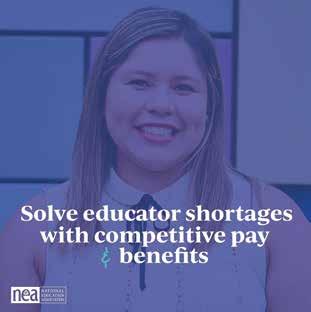
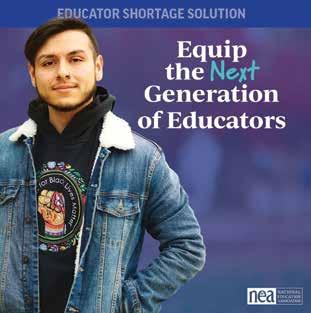
and a lineup of important support positions and programs in our schools—all steps that will make life in the classroom a lot more appealing to current and potential teachers.l
Allen is the editor of the Virginia Journal of Education.
12 VIRGINIA JOURNAL OF EDUCATION | DECEMBER 2022 VIRGINIA JOURNAL OF EDUCATION | DECEMBER 2022 13 COVER STORY Photo pge 12 by iStock
The Next Step
Professional growth opportunities for education support professionals

If you’re an education support professional doing the essential work provided every day in our public schools by ESPs, you and your colleagues make up more than one-third of today’s school workforce, and you need and deserve professional development as much as any other educator. The National Education Association is making sure you have access to some very high-quality options.
Here’s a sampling: Webinars. NEA’s ESP Learning Network offers a lineup of informational sessions you can see online, usually whenever your schedule allows. Some offer professional development certificates, too. Some of the topics for future webinars and those already recorded and on the NEA website:
• Equitable Discipline and the Role of an ESP.
• Avoid the Burnout: How Taking Care of You is the First Step in Meeting the Needs of the Whole Student.
• Do You See Me? The Importance of Pronouncing Names Correctly.
• Changing the Lens to Change the Outcome, which helps ESPs build resilience. Many of the ESP webinars are also available in Spanish.
Peer mentoring. Nothing matches having a seasoned pro walk beside you as you grow in your skills and responsibilities. Effective mentoring can successfully support that growth, give you a greater voice in the workplace, and contribute to the overall school mission of student success. NEA has created a guide for establishing an ESP peer mentoring program and also offers an online course to guide you through the process.
Professional Learning Programs. ESPs have access to a variety of training and networking events, including:
• ESP Professional Growth Continuum (PGC), which uses eight universal standards to guide learning and growth.
• ESP National Conference, an annual event bringing ESPs of all job descriptions together to build relationships, organize, and sharpen skills.
• Building Winning Teams, a training package focused on developing effective paraeducator-teacher partnerships.
• Anti-privatization support for affiliates where ESP members face the threat of having their jobs outsourced.
• Micro-credentials, a short, competency-based recognition for all educators, including ESPs.
Publications. You can get brochures and downloadable documents with titles that include ESPs: Who We Are; Meeting the Needs of the Whole Student; Bullying Prevention; Making Connections: Engaging Members in Building Community Support; and more.
To learn more about all these opportunities, start with a visit to nea.org/esp.l
Identity, Manipulatives, and Mistakes
A better way to teach math.
By Sarah Flippen
The way we teach math is changing, and while those changes are almost all for the good, they do come with some challenges for educators. Years of research are showing us that we need to move math classes away from sedentary environments where students just sit quietly and take in information toward more engaging situations filled with critical thinking, collaboration, and discussion. The challenge for many teachers is that they never experienced this as
students.
As a beginning teacher, I launched into math instruction as someone who’d been a strong student and found math work easy to complete. However, I quickly realized that just because I was a strong math student did not mean I was a strong math teacher. I had a difficult time explaining how and why math worked because while my math experiences taught me to follow procedures to get the
correct answer, there was no focus on why the answers made sense and rarely anything about how math was applicable to the real world. After hunting for new ideas and ways to improve, I began to unlock my own conceptual understanding and found new instructional tools, including number sense routines, tasks, different types of assessments, quick checks, CRAs, lesson studies, counting collections, and so much more. In fact, there were so many amazing resources and strategies that at times felt overwhelmed by the things I wanted to fix, change, or add to my teaching. After serious consideration, I’ve pinpointed three areas that I’ve found most transformative in my classroom. They’re easy places to begin, but they’re also sometimes easily overlooked:
• Take time to build math identity and community
• Use manipulatives
• Give space for and teach about mistakes
Identity and community.
As educators and as a society in general, we’ve begun to prioritize strengthening our social and emotional health and developing a positive self-identity. When we think about self-identity, we often think about how people view themselves, their appearance, personality, and place within their community. We don’t often consider one’s identity as a learner or, more specifically, as a learner of math. Math has a tough reputation for being a boring subject, one few people truly enjoy.

The Virginia Public Education CoalitionTheT FEATURE STORY Photo and Illustration by iStock VIRGINIA JOURNAL OF EDUCATION | DECEMBER 2022 15
FEATURE STORY
14 VIRGINIA JOURNAL OF EDUCATION | DECEMBER 2022
Imagine being a child and hearing your family discuss how to figure out the tip at a restaurant, having a guardian not understand your math problems when helping with homework, or even hearing your favorite teacher remark on how they didn’t enjoy math when they were in school and you will all just “get through it together.” All these subtle messages work their way into how our math identity is shaped, in addition to what I find challenging or enjoyable, and what understand as a student.
A simple strategy for any math teacher is spending some time fostering a positive math identity in their students. Talk with your students about what they—and their families and friends—think about math. Check in with them as they work and learn about what they’re understanding and be intentional about showing how what they’re learning will be useful in everyday life. With my primary grade level students, I’ve added “I can” statements into math lessons, which focus on their growth as a learner. Some
examples: “If it gets hard, I can persevere,” “I am a critical thinker,” or “I am a mathematician.” We talk about what the words mean as we read them and do this routine daily so the students get the message that they’re capable of doing and thinking about math. I also want them to know that even when they’re capable of it, it doesn’t mean math will always come quickly and easily; they’d have to persevere. I point these traits out throughout lessons, saying things like, “I like how you persevered when working on that problem and even though it was challenging you were able to figure it out.” If you want more information in this area, one of my favorite books is Productive Math Struggle by SanGiovanni, Katt, and Dykema. They include tons of ideas for building math identity for students and class communities.
Using manipulatives. This is another area where most of us can improve. Think about when you learn something new. You may ask things like “Can you just show me?” or “Let me try because I learn better by doing.” If we know that we prefer
a hands-on approach to learning, why don’t we use it in math instruction more frequently? There is a learning trajectory with new information or unfolding the ideas behind a procedure. We start in a concrete stage, using manipulatives and models to see and move things around to deepen our understanding. As our brains familiarize themselves with the patterns and what’s happening, we can move to a representational stage, where we can work without physically having something but instead use pictures and drawings to represent what’s happening in the math. Finally, we can reach an abstract level of understanding where we can use numbers and equations to solve the math.
An example of this would be using base-10 blocks for place value, transitioning to drawings, and then only needing to look at the digits to determine what each place’s value means. You could also consider the concept of area. Students begin using tiles to build and determine the area of a space, then transition to drawing it out on grid paper, and finally move to multiplying the numbers to determine the area. There are many ways to do this, but many math classes solely function at the abstract level. In these situations, what tends to happen is only the students who can memorize the procedure succeed. And often, even these students don’t fully understand why the math works, which can make it hard for them to determine the reasonableness of their answers. This can also explain why students return from summer having forgotten some of what they learned, or why you may struggle to help someone with math work that you don’t teach—you may not remember how to solve it because you didn’t understand how or why the math worked.
I was in this same boat and honestly didn’t even realize it. Though math was one of my best subjects as a student, when I began teaching, I realized I had a hard time explaining it to struggling students. It wasn’t until was working on my master’s that I realized I had a very surface level understanding of math. In that coursework, I had to use manipulatives and take pictures, write out my thought process and how I knew my answers were right, and compare my work with the work of others who solved the problem in a different way to determine why both methods worked and if they’d work in every situation. These experiences opened my eyes to how much we expect students to understand using just a piece of paper, pencil, numbers, and symbols, and decided to make math a hands-on subject in my classroom.
I began using as many types of tools and manipulatives with my students as I could. This meant that they became familiar with 10 frames, rekeknreks, number bonds, counters, cubes, base-10 blocks, and more. Students could see that there are many different ways to solve a problem, and they learned to use different tools. If they didn’t understand the content by using one tool, there was another I could use to help them make a connection. Experimenting with different tools also allowed them more autonomy. They were able to choose which tool was best for them, giving them the ability to ask for what they needed. It was a beautiful sight to see students move flexibly between tools and pick out the one that worked best for them. I saw them moving away from needing concrete materials to solve problems representationally; some began drawing pictures or using their fingers to solve problems. By the

end of the year, I also had students who had moved to an abstract mastery of content using tools only as an afterthought or when they needed to verify their thinking.
Mistakes. Research shows that as we make mistakes our brain grows, yet for some reason many have come to believe that mistakes are a sign of weakness. I’ve worked for years on developing an understanding of math learning and instruction and know that being able to rapidly recall facts or solve mental math problems quickly doesn’t make you more or less smart. Still, when someone asks me a math problem on the spot, I feel my anxiety rise and worry that my inability to correctly answer their question quickly will take away my reputation as a math leader or an intelligent person. Luckily, know better and after the initial seconds of panic, I can remind myself that don’t need to know the right answer immediately; if I get it wrong it says nothing more about me than I’m human.
Students don’t automatically know this. When they’re not able to quickly devise an answer or when they make a simple mistake, they feel “less-than” or question their intelligence. It’s our job to show students that mistakes are a normal part of the learning process. However, we have to go beyond even that and teach that making a mistake can help us to persevere and adjust our strategy. Allowing students room to make mistakes and the power to grow from them gives them autonomy not just in the classroom but sets them up to be lifelong learners. Have students reflect and talk about what it feels like to make a mistake. Compare it to other areas that our society is more comfortable with when it comes to making mistakes, like a baby walking
for the first time or a child learning to ride a bike. Help students make the connection that growth from mistakes and struggle ultimately leads to learning and mastery. Ask them to reflect on mistakes they’ve made or connections they learned from making the mistake. When you have students learn from a mistake, ask them to show the class where they went wrong and what strategy or steps they took to get to the right answer. Taking the time to teach the value of mistakes might be the most important lesson any human can learn.
As we allow our classrooms to be places where students’ mistakes are welcome, we also need to give ourselves the same room and freedom. As you begin to experiment with different strategies and try to add new things, you’ll make mistakes and some efforts will not work out perfectly. I remember hearing about a new math strategy and being very excited to implement it and share it with co-workers. They all came into my classroom to watch me try it out—and it was an utter failure. Many of the students were unable to finish the activity. After a bit of initial disappointment and embarrassment, and a lot of reflection, I tackled the activity again and again, improving my plans and allowing myself to see the possibilities in the missteps. Flash forward: I’ve now presented on it at a state conference. Give yourself a chance to try something new, allow yourself to take some missteps along the way, and allow students a better understanding of math and of themselves as math students, and let them be learners who can make mistakes!l
Flippen, a member of the Caroline Education Association, is a math specialist at Madison Elementary School.
VIRGINIA JOURNAL OF EDUCATION DECEMBER 2022 17 Photo by iStock
FEATURE STORY 16 VIRGINIA JOURNAL OF EDUCATION | DECEMBER 2022
We Need a Deeper Dive

Test scores
By Bill Pike
In August, the Virginia Department of Education released the annual compiling of our students’ Standards of Learning test scores and, more recently, the scores on the National Assessment of Educational Progress (NAEP) tests came out nationally. Such events are always met with headlines and comments from appointed and elected officials, and this year was certainly no exception.
Coming on the heels of a global pandemic, it came as no surprise that student performance was down when compared to pre-COVID results, even after herculean efforts from school systems and educators to maintain learning by switching from in-person classes to virtual instruction. Unfortunately, the family and technology infrastructure needed to make online learning successful was not always in place. As a result, I believe it will take students, their families, and teachers years to recover from this significant disruption.
Reacting to the SOL scores, Virginia’s Superintendent of Public Instruction, Jillian Balow, noted that while we
were fighting achievement gaps before COVID, we are now even further from closing them. Why are we always trying to recover ground related to achievement gaps in Virginia?
Virginia’s students began taking SOL tests in 1998. What have we learned from 24 years of testing data? Are we any better equipped to understand students, their families, our communities, schools, and teachers now than we were then?
believe test score data is very incomplete and can be misleading. For example, in single-parent homes during the pandemic, does the data capture the impact felt when older siblings miss multiple middle and high school classes to care for younger siblings?
Does the data uncover the effect disruptive students have on their own learning, and the learning of classmates?
Does the data reveal the consequences of prolonged achievement gaps?
Are these gaps grounded in our inability to solve malignant challenges related to family, poverty, mental health, housing, safety, and equity?
Does the data capture the morale of teachers who attempt, every day, to deliver high-quality instruction in increasingly challenging environments?
If we hope to recover instructional ground and close achievement gaps, we must commit to the hard work of answering those questions, and more. And it will be hard work, much more difficult than merely collecting test scores and then making public statement about them. Continuing to place blame for unsatisfactory SOL test results on the shoulders of teachers and school system leaders is misguided.
Maybe a week shadowing a teacher in a challenging school could change the minds (and comments) of some of our elected and appointed officials.
Since some of us are quick to blame disappointing SOL scores on teachers, I wonder if Governor Glenn Youngkin’s “tip line” saw an uptick in calls when the SOL and NAEP test scores were released. Additionally, I wonder if that “tip line” contributed to the current teacher shortage school systems face?
Truthfully, school systems have always scrambled to fill teaching positions before each new school year begins. In 1975, I began my teaching career as a last-minute hire and, as an administrator, I was later on the other side of making those hires. We have witnessed many changes since then. Often in immeasurable ways, students are affected by disruptive changes in their families and communities. Despite these changes, teachers are continually asked to be “first responders” to our societal challenges, while still delivering excellent instruction.
If we truly want to both improve standardized test scores and close achievement gaps, we need to move beyond predictable political finger-pointing. With urgency, we must commit to a deeper dive into the troublesome data, because troublesome numbers are not just statistics—they represent struggling students. Struggling students who desperately need our help. For too long, we’ve overlooked the multiple needs of many of them. We can’t afford to do so any longer. Understanding how the academic potential of these students is affected by family, poverty, mental health, housing, safety, and equity factors is pivotal. And while it will be complicated and involve more effort, if we fail to make this discovery for every struggling student, then we will neither see improvement in SOL scores, nor will we close gaps in achievement.
For too long, we have failed to adequately address how these vicious generational patterns impact our classrooms. The unsteady family, the single parent working three jobs, the fragile, volatile student who urgently needs mental health services, the family who is crammed into a hotel room or living out of a car, the unsafe neighborhood, and the widening division of equity all reside within the walls of a school building.
Those unwavering human infrastructure challenges impact every person employed in a school, and embedded in that impact is morale. It is quite possible that morale is at the heart of every teacher resignation and every personnel opening a school system is advertising to fill. The tension of this human trauma makes me wonder if our vision for educating the children in our communities is outdated and no longer adequate.
Maybe this quote from Margot Lee Shetterly, author
of Hidden Figures, says it best: “You don’t get the good without the bad, but you really do have to see it all in order to make progress.”
In Virginia, if we are going to make progress with test scores and achievement gaps, we must work together “to see it all” for every student.l
Pike is a retired educator who spent 31 years in Virginia’s public schools as a teacher, coach, and administrator.
18 VIRGINIA JOURNAL OF EDUCATION | DECEMBER 2022 VIRGINIA JOURNAL OF EDUCATION DECEMBER 2022 19 Photo by iStock FEATURE STORY
alone don’t tell us what we really need to know.
Virginia’s students began taking SOL tests in 1998. What have we learned from 24 years of testing data? Are we any better equipped to understand students, their families, our communities, schools, and teachers now than we were then?
VEA Summit Will Focus on Teachers of Color

VEA members have taken leadership roles in the effort to build a more diverse teaching force in Virginia, launching our first statewide conference on this topic in 2017. To keep the momentum going, put these dates on your calendar—February 17-18, 2023— and plan to be in Norfolk for our Union’s 2023 Summit on Teachers of Color.
If you’re a teacher, ESP, administrator, college students, school human resources professional, higher education faculty member, local school board member, or are involved in education policymaking, you’ll learn valuable information about the importance of having a teaching force that more accurately represents our student population.
We’ll be addressing issues including the removal of barriers that hamper minority teaching candidates, diversifying the educator pipeline, retaining teachers of color, improving working conditions, culturally relevant practices, compensation, and cultivating community.
We’ll also have a keynote address from Dr. Bettina L. Love, award-winning author and professor at Teachers College, Columbia University.
The event’s theme is “Mirrors: Reflective Practices to Empower All,” and will be held at the Hilton Norfolk The Main. To learn more and to register, visit the Summit’s page on VEA’s website, veanea.org/toc-summit.l
More information, and to register: www.strongschoolsva.org
Property Taxes and School Funding: An Uneven Recipe

Does this sound fair? According to the most recent VEA research, there are 13 localities in Virginia that have used their property taxes to come up with over $10,000 to spend on every student in their public schools. At the same time, there are 53 that are working with less than $4,000.
Another property tax and school funding item, from The Commonwealth Institute, a nonpartisan research organization based in Richmond, points out the challenges associated with using property taxes to pay for schools: A one penny increase in the property tax rate in Arlington, for example, would raise $8.1 million, while a one cent increase in Russell County would yield $143,800. l
VEA-Retired to Pilot New National Program
Congratulations to VEA-Retired members for being selected as one of only 10 states nationwide to pilot a new membership recruitment and engagement project! Using funds provided by the NEA Coalition of Retired Activists and Leaders (CORAL), a statewide team of VEA-R members, led by Vashti Mallory of Richmond and Barbara Wilson of Louisa, will launch our state CORAL program in January. Its primary goals are recruiting new members across every membership category, with an emphasis on retirees; formation of partnerships across membership categories; increased presence of all membership categories at each statewide event for the purpose of promoting membership; and development and implementation of local CORAL teams across the state by the end of the first year.l
Know Anyone Deserving? Educators, Organizations to be Honored with VEA Awards
The meaningful and excellent work being done by Association members and others who give time and talent to the cause of public education should not go unnoticed. To be sure it doesn’t, VEA’s annual awards program honors efforts made on behalf of our young people and our schools, and so nominations are now open for the following VEA awards:
• Friend of Education Award. VEA’s highest honor recognizes an individual or organization whose leadership, acts or support has significantly benefited education, education employees or students in Virginia. Nomination deadline: January 6, 2023.
• Fitz Turner Award: Honors outstanding contributions in intergroup relations and the enhancement of respect for human and civil rights. Nomination deadline: January 11, 2023.
• Mary Hatwood Futrell Award: Honors leadership in fostering equality in educational opportunity and promoting equity and excellence in public education. Nomination deadline: January 11, 2023.
• Barbara Johns Youth Award: Honors a student or student organization whose activities promote the dignity and esteem of others. Nomination deadline: January 11, 2023.
• Award for Teaching Excellence: The highest honor VEA gives for creativity and excellence in the classroom. Nomination deadline: January 22, 2023.
• VEA Fund Award for Political Activism. Honors VEA locals for outstanding achievement in political organizing and activism. Nomination deadline: December 9, 2022.
• Robley S. Jones Political Activist Award: Honors individuals for their contributions to education legislation or policy, or to the election of public education-friendly candidates. Nomination deadline: December 9, 2022.
• Education Support Professional of the Year: Honors the contributions of an ESP to his or her school, community and profession. Nomination deadline: January 9, 2023.
• Martha Wood Distinguished Service Award: Honors a retired educator who has made significant contributions to the growth of the active and retired Association, the promotion of public education, and the welfare of public educators. Nomination deadline: January 9, 2023.
• A+ Award for Membership Growth: Honors local Associations for growth, given in three size categories.
For more information, visit www.veanea.org/grants l
What We Stand For
These core values, determined by VEA members, guide our work and define our mission:
• Equal Opportunity. We believe public education is the gateway to opportunity. All students have the human and civil right to a quality public education that develops their potential, independence, and character.
• A Just Society. We believe public education is vital to building respect for the worth, dignity, and equality of every individual in our diverse society.
• Democracy. We believe public education is the cornerstone of our republic. Public education provides individuals with the skills to be involved, informed, and engaged in our representative democracy.
• Professionalism. We believe that the expertise and judgment of education professionals are critical to student success. We maintain the highest professional standards, and we expect the status, compensation, and respect due all professionals.
• Partnership. We believe partnerships with parents, families, communities, and other stakeholders are essential to quality public education and student success.
• Collective Action. We believe individuals are strengthened when they work together for the common good. As education professionals, we improve both our professional status and the quality of public education when we unite and advocate collectively.
VEA also believes every student in America, regardless of family income or place of residence, deserves a quality education. In pursuing its mission, we will focus the energy and resources of our members on improving the quality of teaching, increasing student achievement and making schools safer, better places to learn.l
VIRGINIA JOURNAL OF EDUCATION | DECEMBER 2022 21 MEMBERSHIP MATTERS
20 VIRGINIA JOURNAL OF EDUCATION | DECEMBER 2022
Lobby Day photos by Lisa Sale; Photo illustration page 20 by iStock
Three VEA Staffers Promoted
Bethany Bizick, our Human Resources Administrator, will move into the position of Human Resources Manager in January. Bethany joined VEA in April 2021, has over 15 years of human resources experience, and has earned her professional certification from the Society of Human Resources Management.

Cathie Lee, VEA Staff Attorney, is now VEA’s General Counsel and Director of Legal Services. She has practiced law for more than 30 years and has been with VEA since 2009, working in areas including collective bargaining, member representation, and staff training.

Chris Yoder VEA’s Controller, will become Director of Finance/CFO and VEA Treasurer, also in January. He’s been with the VEA since 2015, beginning as Senior Accountant before becoming Controller in 2019. He also worked for over 25 years in capacities as Controller, Director of Finance and Administration, and CFO for two non-profit organizations before joining VEA.l
Keep Your VRS and Other Accounts Safe from Identity Fraud
Identity thieves are out there, and if they get your personal information, can drain accounts, make unauthorized credit card purchases, open new accounts and initiate other transactions in your name. Here are some essential steps you should take now to help protect yourself against fraud.
Claim your online accounts.
• Claim your myVRS account (myVRS.varetire.org) by completing the identity-verification steps and then establishing a password-protected account. Log in at least every couple months to keep your password current and explore retirement planning resources.
• If you are a hybrid plan member or participate in one of VRS’ defined contribution plans, visit varetire.org/dcp, select your plan and then Account Access. Follow the registration steps.
• Know when you’re at risk. Some warning signs of potential identity theft or fraud:
• You receive mail from companies with which you have not conducted business.

• You receive mail at your current address with someone else’s name.
• Emails arrive that look like correspondence from a company or organization you know but make unusual requests. VRS will never ask you to provide personal information via email, including your date of birth, Social Security number or account number.
• You don’t receive your credit card bills or other financial statements.
• Debt collectors call about debts that aren’t yours.
• You receive notice that your information was compromised by a data breach at a company where you do business or have an account.

Report identity theft. The Federal Trade Commission has created IdentityTheft.gov, which features an online tool that helps victims report and recover from identity theft. And, if you notice any suspicious changes to your VRS accounts, call VRS at 888-827-3847 or email member-info@varetire.org. See VRS’ Security Center at varetire.org/securitycenter l
PRESIDENT’S MESSAGE
Classrooms are No Place for Partisan Politics
— Dr. James J. Fedderman
What we teach our children is supposed to be about preparing them for successful futures in an ever-changing global society. It’s not supposed to be about sending them into that society with a particular political philosophy.
We’re seeing way too much interference in what goes on in our classrooms now that seems not to be focused on what’s best for our students, but what’s best for some of our leaders’ political interests. And it’s not right.
Take, for example, the proposed changing of our K-12 history standards. As is periodically done, those standards were recently reviewed by a group of qualified educators, who also incorporated input from some of Virginia and the nation’s top historians and curriculum experts. The process was transparent and was moving forward smoothly.
However, the Youngkin administration apparently felt the need for a re-do. First it delayed the process, then it released its own set of draft standards after bringing in its own set of “experts” who share the administration’s politics.
The new drafts are the worst kind of politically motivated meddling with academic curriculum. The disruption of the process brought this reaction from Virginia Board of Education member
Ann Holton: “I don’t understand who are the voices that want to weigh in on this that haven’t been paying enough attention to have weighed in by now.”
The draft standards are loaded with
political bias, use outdated language to describe enslaved people and American Indians, and create additional pressure on educators to present “balanced” views of historical issues like discrimination and racism while restricting “teacher-created curriculum,” which is allowed in other subject areas.
As I write, we are also absorbing the impact of the senseless tragedy at the University of Virginia. Classrooms and campuses should be safe havens where young people feel welcomed. We are brokenhearted for the students and educators who survived this terrible event and will continue to feel its effects for years to come.
We are also angry. How have these events become part of our national culture? We cannot stand by. We challenge elected leaders across the country—and here in Virginia—to no longer side with the gun lobby and instead speak up for those who are caught up in the preventable epidemic of gun violence. Our students and their families, as well as our colleagues and our communities, deserve safe schools—and we all deserve leaders who value our lives over their campaign contributions.
It’s time—long past time, actually— for self-interested political thinking to be put aside as we work toward creating and sustaining the kind of public schools we all want.l
Richmond’s Johansen Earns State Economics Teaching Award

Ingrid Johansen a Richmond Education Association member and an Economics and Personal Finance teacher at George Wythe High School, has been named Virginia’s 2022 Outstanding Economic Educator by the Virginia Council on Economic Education. Among VCEE’s 2022 regional honorees were Erin Merrill of the Prince William Education Association, Penelope Millar of the Prince William Education Association, and Pamela Dalton of the Montgomery County Education Association.
The R.E.B. Awards for Teaching Excellence recognize outstanding teachers in the Richmond metropolitan area with cash grants for professional growth and travel. Among the 2022 winners are Kara Barton of the Chesterfield Education Association and Old Hundred Elementary School; Jamar Billups of the Richmond Education Association and Armstrong High School; John Ryan Nunez of the Richmond Education Association and Franklin Military Academy; Victoria Parent of the Chesterfield Education Association and Monacan High School; Ashleigh Russell of the Richmond Education Association and
Albert Hill Middle School; Monica Thomas-Moore of the Richmond Education Association and Barack Obama Elementary School; and Julia West of the Chesterfield Education Association and Providence Middle School.
Virginia Beach Education Association member Cameron Baker a band teacher at Kellam High School, has received a 2022 Music & Arts Grant from California Casualty.
Grant money will go toward the purchase of new instructional materials for student musicians.l
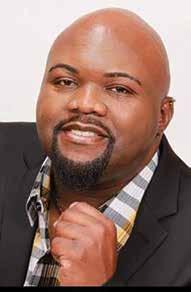
VIRGINIA JOURNAL OF EDUCATION DECEMBER 2022 23 KUD S
MEMBERSHIP MATTERS 22 VIRGINIA JOURNAL OF EDUCATION | DECEMBER 2022
Photo page 22 by iStock
Teacher
Leadership: Those ‘Closest
to the
Pain’ Should also be ‘Closest to the Power’
When it comes to what goes on every day in our public schools, says Lauren Jewett, a special education teacher in Louisiana and a NBCT, teachers are the ones “closest to the pain” and therefore should “be closest to the power.” Writing for the U.S. Department of Education, she notes that teachers have to deal with the day-to-day realities of policies often created without the opportunity for those in the classroom to have a say.
Our best hope for getting hands-on educators closer to the decision-making process in our school systems? Advocacy, she says. “By advocating,” she says, “teachers ensure that they are putting themselves in proximity to power and bringing their stories of joy and pain to the policymaking spaces and decision-making tables.”
She offers these tips for more effective advocacy as teachers, all of which you, as a VEA members, have ready-made opportunities to follow through on:
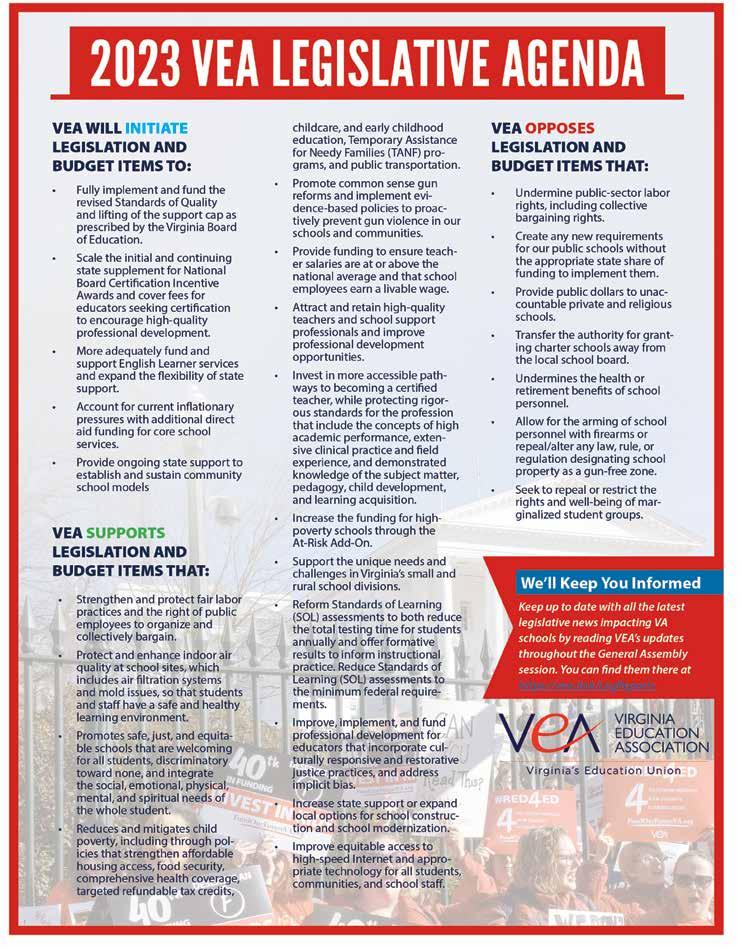
• Know, practice, and refine your story: Part of being a teacher leader and advocate is sharing your story, especially with those who can enact policy changes. Our stories are what bind us, and they have the capacity to change hearts and minds.
• Identify your passions and network with those who share them: Know your unique education passions and interests, cultivate them, and become an expert. Network with those connected to your passions and use those connections as springboards to dive deeper into advocacy work.
• Research and stay up-to-date on education policies and legislation: This will help you become well-versed in trends and statistics, and knowledgeable about the ways policies and legislation affect you, your colleagues, and your students. It is also important to understand how you can work with your representatives on bills pertaining to education.
• Attend meetings about education issues: Most meetings about education that affect teachers’ day-to-day realities will be local or state school board meetings, state legislative committee meetings or hearings, or local community meetings. Educators can also engage in focus groups, town halls, district or superintendent advisory councils, and standards/curriculum committees. Within school buildings, teachers can also advocate as members of their grade level teams, IEP teams, RtI and MTSS teams, interdisciplinary teams, and subject/content area teams.
• Identify and keep in contact with elected officials and decision-makers: Organizing meetings, writing letters, and engaging directly on social media are all concrete ways to demonstrate to policymakers that you know and care about education.
• Vote: Vote in every election, not just every four years during the presidential cycle. Many important decisions around education are made by candidates running for local, municipal, and state offices. When you go to the polls to cast your vote, make sure you have done your homework about the issues and candidates on the ballot.
• Write op-eds, blogs, and articles: Writing op-eds for the local newspaper and contributing to education blogs helps ensure that teachers’ voices and perspectives are heard.l

VIRGINIA JOURNAL OF EDUCATION | DECEMBER 2022 25
| INSIGHT ON INSTRUCTION
Photo-illustration by Stephen Gwaltney
MEMBERSHIP MATTERS
GEEO Offers Discounts, Credits on Educator Travel
Global Exploration for Educators Organization (GEEO) is a nonprofit group that helps classroom teachers travel, earn professional development credit, and bring diverse global perspectives into their instruction.

Programs are 5 to 23 days in length and include educational materials. In 2023, GEEO is offering trips to over 50 countries on five continents, with flexible registration dates and limited space. To learn more, visit geeo. org or call toll-free at 1-877-600-0105.l
We Need Lots More Role Models
More than half of our country’s public school students are children of color, but Black men make up just 2 percent of our teachers.l
 Source: Stanford Graduate School of Education
Source: Stanford Graduate School of Education
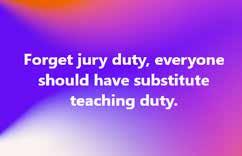
‘Our Children are not OK’
have seen [our student mental health] crisis firsthand; our children are not OK. Students come to school much more anxious than they ever did before. This anxiety has many causes. Students struggled with the return to in-person schooling, and a full year in the classroom has not fully eased the transition. In some ways, this is the first “normal” post-COVID year, as students are no longer learning in hybrid fashion or quarantining to the same extent as before.

With this “normal” year comes great anxiety. For some, it stems from social interactions that fundamentally changed during online learning, making the return to school more stressful than ever. For others, it is from family issues or the loss of a loved one during the pandemic. For still others, it begins with a drive to succeed academically, something which looks much different during in-person learning than it did online.
Students cannot learn when they are struggling mentally and emotionally. So what can we do about this crisis? The answer must include multiple solutions. If doctors follow the recent suggestion to screen all adults for anxiety, they should not stop there. Our children need mental health check-ups just as much as their parents. This would allow health professionals to catch a child’s mental health struggle before it snowballs.
In addition, schools can continue implementing social emotional learning strategies, which can help to teach students social skills and coping strategies for the post-COVID world. At home, parents can follow this up by discussing mental health with their children and providing them with strategies to lower their stress.
It is often said that it takes a village to raise a child. As a teacher, can tell you this is certainly the case. Parents, schools, and the wider community must band together to address the youth mental health crisis in order to make the biggest difference for our students. Only then can we move forward and address academics.l


More States Getting Student Voices into Policymaking
2022 figures show that in 33 states, students are now serving as either members of the state board of education or on an advisory council to those bodies, as states broaden their efforts to bring student perspectives into education policy discussions. Four years ago, only 25 states had youth representation at that level.
According to the National Association of State Boards of Education, more than 400 students currently serve in those capacities across the country. Eighteen states have no student representation; Virginia’s advisory group of 10 students is among the most recently created.l
Take Students for a Walk on the Wild Side
Monthly livestreams, hospital and critter cams, direct live programs, on-demand courses, even a program called Caring for Critters—all are among the resources available to educators and their students from the Wildlife Center of Virginia.
The organization was formed in 1982 and has provided health and emergency care for more than 85,000 wild animals since, including birds, mammals, reptiles, and amphibians. It’s also shared lessons with some 1.5 million Virginia children and adults. Located in Waynesboro, the Center also offers on-site and online tours.
To learn more, visit the Center’s website at wildlifecenter.org or reach out through edu@wildlifecenter.org l
Schools Mean the World to Kids and Families
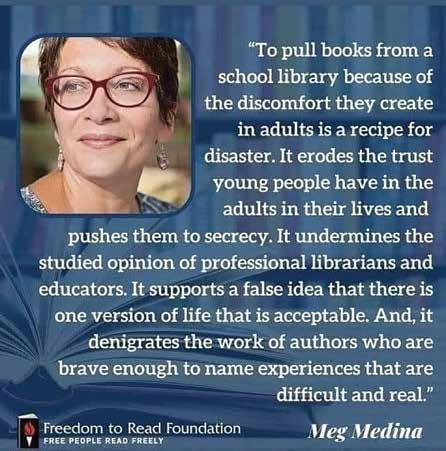
Schools can be, and need to be, spaces that are replete with joy for students. We discovered during the school closures of 2021 just how important schools are to the holistic development of young people. Schools need to be places where students laugh, learn, explore, talk, think, create, imagine, dream, and feel good about themselves and others.l
A five page report? Do you know the trend now days is to go paperless?
26 VIRGINIA JOURNAL OF EDUCATION | DECEMBER 2022 INSIGHT ON INSTRUCTION Photos and illustration by iStock
VIRGINIA JOURNAL OF EDUCATION | DECEMBER 2022 27
— Williamsburg/James City Education Association member Rachael Rudis, writing in the (Newport News) Daily Press and (Norfolk) Virginian-Pilot
— Tyrone C. Howard, professor of education, UCLA Graduate School of Education


In her General Biology class, as part of the Genetics Unit, she’s developed a scenario where a murder has been committed and students have to engage in deductive reasoning to catch the culprit.
“There’s even a crime scene with a body outline, with ketchup as blood, surrounded by yellow caution tape,” Eversole says. “Students can examine the murder weapons, either scissors or a stapler, and interview teachers who have volunteered to be suspects with one of them being the designated murderer.
“Students have to examine a whole range of genetic clues such as Punnett Squares (eye color), blood typing, and the microscopic investigation of a hair. Then to help develop their writing skills, students compose a paper about which teacher is the one most likely to be guilty. Students really love doing this, and they learn some great concepts at the same time.”
Amazing, Creative Lessons Happen Every Day

Every year in my English 10 classes at Lord Botetourt High School, teach several units that I’ve generated over the years. One of them is the 1940s/World War II Unit, in which my students create and present PowerPoints on historical events, sports, fashions, cars, music and, of course, the war itself. We also read a young adult novel, Heroes, about a teen who lies about his age and goes off to war. For the unit’s capstone, I invite a local World War II veteran to come speak to the students.
This fall, I asked Joe Damiano, a 100-year-old vet from Salem, who came and regaled my students (as well as students in several history classes at our school viewing virtually from their classrooms) about his time overseas.
Other VEA members here craft creative units, too. For instance, Eric Rader, who has taught at our school for 11 years, has devised a marvelous unit on Middle Ages feudalism.

“It’s a role-playing game where every student has a designated class in life such as serf, knight, priest, or king,” he says. “The catch is that I’m the pope, and I manipulate daily life to benefit me because have all the advantages of my station. even dress up like a pope.
“A goal of the unit is for the students to learn how rigid the feudalistic system was and how the lower classes had almost no opportunity to advance. Some students become frustrated at that and say that they will assassinate the pope. I tell them how hard that would be to do and even if they succeed, my successor will wipe out their entire family.”
Another VEA member who has devised a thought-provoking lesson is Susan Eversole, who has taught here for 14 years.
Jessie Curulla has taught English for 15 years here and her Dual Enrollment 111 and 112 classes have this challenging assignment:
“One writing strategy use is the double-entry journal,” she says. “Students divide a paper into two columns; the left side contains evidence from the text to support their point and the other side should be commentary. Using proper MLA quotations, students select five quotations that will strengthen their arguments.
“The students’ commentary should analyze how the evidence proves a prompt’s question or the essay’s thesis. Students write four to five lines of analysis for each piece of evidence. This enables them to critically think and validate their opinion based on the evidence they’ve found in the text and overall strengthens their analytical skills for college.”
My point here is that not only do we VEA members create outstanding lessons every day in schools across the Old Dominion, but that we also need to do a better job of promoting what we do through old and new media. For instance, Mike Moser, the PR person for Botetourt County Schools, contacted local media outlets about the WW II vet visiting my class. Two television stations sent reporters, and the county’s weekly newspaper, The Fincastle Herald, sent its editor.
When learned the editor was coming, I contacted him and set up an interview session and classroom visit with him. The editor observed my students presenting their PowerPoints and interviewed several young people, whose enthusiasm for the unit was clear. The result was positive publicity for the school, as well as a memorable experience for students. So this year, don’t hesitate to promote yourself and your fellow teachers. We deserve more positive publicity for the great work we do, and it’s up to us to make that happen.l
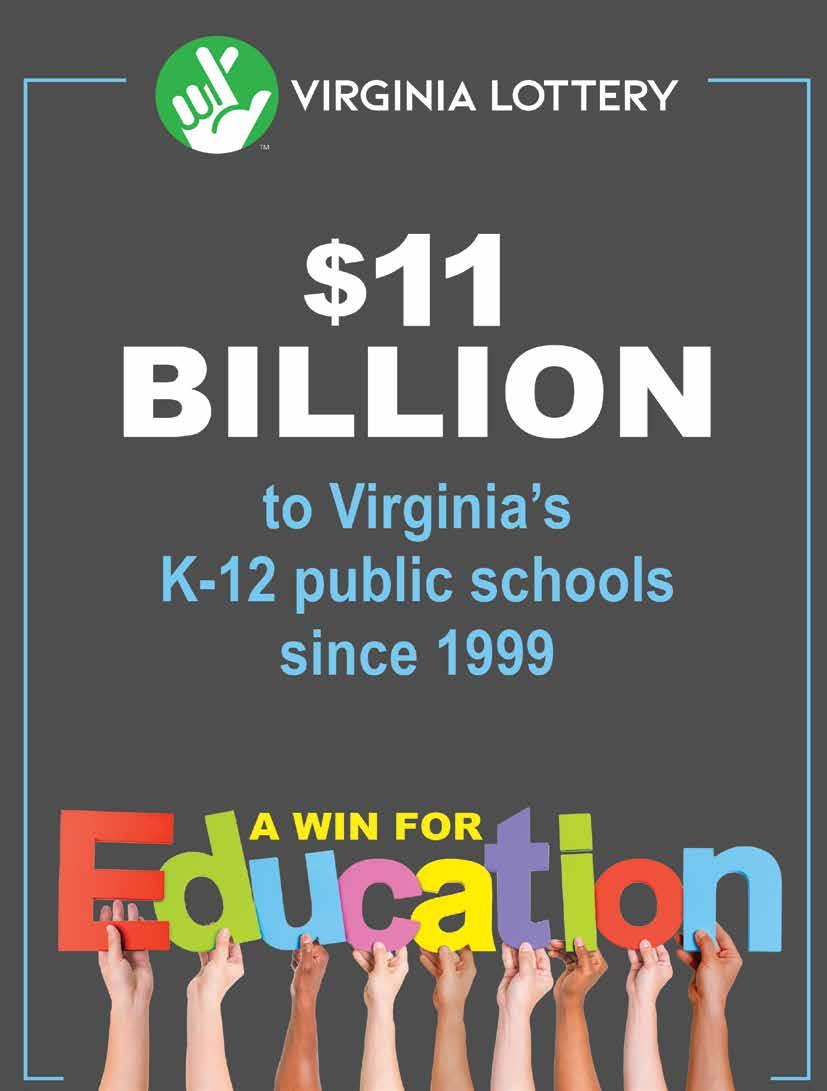
30 VIRGINIA JOURNAL OF EDUCATION | DECEMBER 2022
FIRST PERSON: NARRATIVES FROM THE CLASSROOM
Bruce Ingram, a member of the Botetourt Education Association and a veteran educator, teaches English and Creative Writing at Lord Botetourt High School.
— Bruce Ingram
Illustration by iStock
A publication of the Virginia Education Association 116 South Third Street, Richmond VA 23219 veanea.org vea4Kids



MASTER OF ARTS IN TEACHING AND LEARNING, where teaching practice, collaborative curriculum development, and building leadership skills are emphasized.


MASTER OF ARTS IN LIBERAL STUDIES, which encourages creating your own graduate degree to fit your needs.

For those teachers who already have a master’s degree, 18 GRADUATE HOURS in English, mathematics, or history qualify you to teach dual enrollment.
CONTACT US to learn more about how we can help you become an extraordinary PK-12 teacher. (540) 362-6575, hugrad@hollins.edu, or visit hollins.edu/grad
Take your teaching
to the next level At Hollins University, our coed, online graduate programs for licensed teachers are designed to challenge and inspire while offering the flexibility necessary for busy schedules.
skills






















 By Tom Allen
By Tom Allen



















 Source: Stanford Graduate School of Education
Source: Stanford Graduate School of Education












